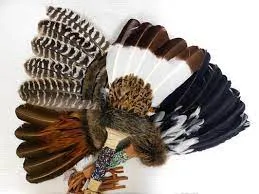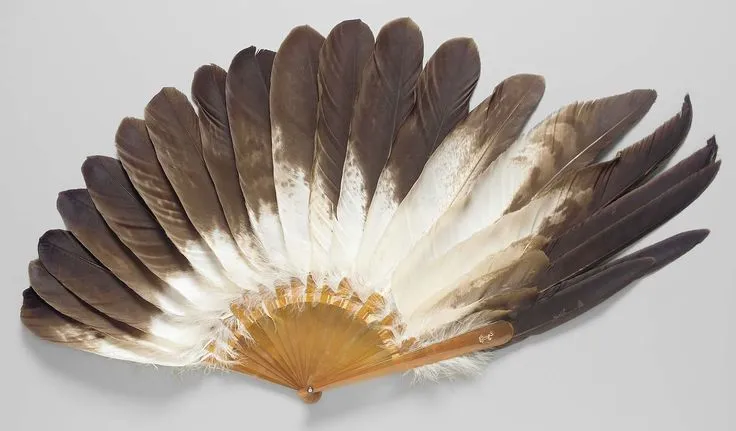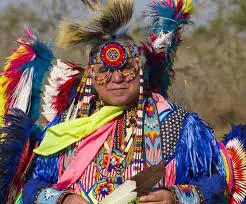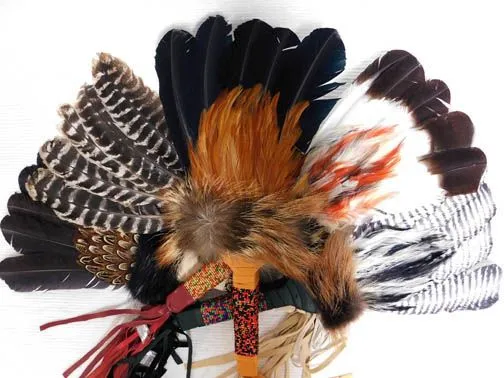Explore the captivating world of Native American craftsmanship as Native American Clothes delve into the art of creating feather fans. These intricate creations are not just beautiful; they hold deep cultural significance and are used in sacred ceremonies.
This guide offers a step-by-step journey into the meticulous process of How To Make A Native American Feather Fan?, welcoming both seasoned artisans and curious beginners to discover the essence of this ancient craft.
What does a feather fan symbolize?

Feather hand fans have a rich history that spans across continents and cultures. These elegant accessories, often associated with sophistication and luxury, have a tale that begins in ancient Egypt and winds its way through time to China, with stops in Greece and Rome. Join us as we unravel the intriguing narrative of feather fans and the cultural shifts they embodied.
The Early Origins in Egypt
Contrary to popular belief, the origins of feather hand fans do not lie in China, but rather in the heart of Africa. Archaeological evidence reveals that the earliest feather fans emerged in Sudan and made their way to New Kingdom Egypt. These early fans were not just fashionable accessories; they held a deeper significance, symbolizing rebirth and renewal.
The Grecian Influence
Around the 400s b.c., feather fans found their way to Greece, introducing this exquisite accessory to the Western world. A century later, Italy followed suit. In these ancient Mediterranean cultures, feather fans became symbols of opulence and sophistication. Possessing a feather fan was not only a display of wealth but also a testament to one’s refinement.
Silk Road Connections
The story of feather fans took an intriguing turn as they embarked on a journey along the Silk Road, traveling from Africa to China through Indian Ocean trade routes. This migration brought about a fusion of cultures and meanings. In China, feather fans became more than just fashionable items; they embodied the complex history of cultural exchange.
Shifting Symbolism

The spread of feather fans across Afro-Eurasia was accompanied by a shift in their cultural associations. While early African and Southwest Asian fans symbolized rebirth, their counterparts in Greece and Rome represented wealth and sophistication. However, at the far ends of the Silk Road, in China and Europe, feather fans took on different connotations.
European Renaissance and Beyond
In Renaissance Europe, feather fans retained their associations with resurrection and sophistication. They were cherished as symbols of refinement and grace. However, with the onset of the Reformation, a transformation occurred. Feather fans began to adopt Orientalist and feminizing connotations, reflecting the changing social and political landscape of the time.
A Tale of Colonialism and Commerce
The evolving symbolism of feather fans was not just a matter of aesthetics; it was intertwined with powerful colonial and commercial interests. These delicate accessories became instruments of cultural exchange, embodying the dynamic interactions between East and West.
In tracing the journey of feather hand fans from their African origins to their role in European Renaissance and their ultimate transformation in China, we gain insights into the intricate interplay of culture, symbolism, and history. Feather fans are more than just fashionable accessories; they are storytellers of our shared human experience, bridging continents and centuries with their delicate plumes.
Do Native Americans use feathers?
Eagle feathers are more than just symbols; they are deeply entwined with the rich tapestry of Native American culture and spirituality. But their significance doesn’t end there; it extends to Federal laws, conservation efforts, and the delicate balance between tradition and preservation.

Legal Eagles: Understanding the Laws
Eagles enjoy the protection of not one but two Federal laws: the Bald and Golden Eagle Protection Act and the Migratory Bird Treaty Act. These laws lay down strict guidelines, prohibiting various activities involving eagle feathers and parts. The intent? To safeguard the majestic eagles and ensure their continued existence in the wild.
Acknowledging Cultural Significance
The U.S. Fish and Wildlife Service recognizes the profound religious and cultural value of eagles to Native Americans. To accommodate these unique needs, they established the National Eagle Repository. This facility serves as a central hub for collecting deceased eagles, salvaged by Federal and State agencies, zoos, and organizations. It’s a crucial step in ensuring that Native Americans have access to eagle feathers for their religious practices.
The Permit Process
For enrolled members of federally recognized tribes, obtaining a permit from the Service is the key to receiving and possessing eagle feathers and parts from the Repository. These permits require certification of tribal enrollment from the Bureau of Indian Affairs. Due to the high demand, waiting periods may apply, emphasizing the eagerness of Native Americans to uphold their traditions.
Other Avenues: Legacy and Gifting
Native Americans are not limited to obtaining eagle feathers solely through the Repository. They can legally possess feathers and parts acquired through various other means. This includes items owned before the implementation of Federal protections in 1940 for bald eagles and 1962 for golden eagles. Feathers and parts passed down within families or received as gifts from other Native Americans also hold a special place in this tradition.
Crafting Culture
These revered feathers, once in possession, can be used in a variety of ways. Native Americans have the freedom to wear them, incorporating them into religious or cultural items for personal or tribal use. They can even entrust these feathers to skilled tribal craftsmen who fashion them into meaningful objects. While money cannot exchange hands for the feathers, craftsmen can be compensated for their craftsmanship.
Passing Down the Legacy
Eagle feathers are not meant to be confined but shared within the Native American community. Gifting feathers or other eagle items to fellow Native Americans and passing them down through generations is a cherished tradition. However, it’s important to note that these sacred items are not to be given to non-Native Americans.

Respecting the Law
Regardless of cultural significance, one crucial fact remains: no one, including Native Americans, may capture or kill eagles without a proper permit from the Service. Buying, selling, bartering, trading, importing, or exporting eagle feathers or items made from them is strictly prohibited. These prohibitions encompass all feathers and parts, even those predating Federal protections.
Enforcing Conservation
Service law enforcement diligently focuses on tackling illegal activities related to eagles, especially commercial exploitation. They aim to protect these magnificent birds from those attempting to profit at their expense. However, individuals in possession of noncommercial quantities of eagle feathers for personal or religious purposes, and possessing valid Service permits or tribal affiliations, generally face no action.
Preserving Tradition
The legacy of eagle feathers in Native American culture is a testament to the enduring power of tradition. The delicate balance between preservation and protection ensures that these majestic birds continue to soar in the wild, while Native Americans can honor their spiritual practices and heritage. It’s a harmonious dance that echoes through the ages, celebrating both nature and culture.
Read more articles Can A Native American Gift An Eagle Feather?
How To Make A Native American Feather Fan?
Materials You’ll Need:
- Feathers: Gather a variety of feathers, preferably from birds like eagles, hawks, owls, or other birds with significant meaning to you or your community. Ensure that you have both wing feathers (for the outer part) and smaller down feathers (for the inner part) for a balanced fan.
- Handle: Select a sturdy, straight stick or dowel for the handle. You can also choose a pre-made handle or use a branch with the bark removed.
- Leather or Fabric: You’ll need a piece of leather or fabric to attach the feathers to the handle. This will serve as the base of your fan.
- Sinew or Thread: Use sinew, strong thread, or artificial sinew for binding the feathers and securing them to the handle.
- Beads and Decorative Elements (optional): If desired, you can incorporate beads, shells, or other decorative elements to embellish your fan.

